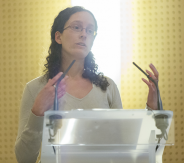Health
Mental Health & Neurology
Brain Mechanisms & Psychology
Ph.D
France
2012.09.30
How do beliefs change? Cerebral mechanisms of conscious and non-conscious interpretative processes
During perception, we do not access an ‘objective’ representation of a word, picture or sound, but we gain immediate access to a subjective interpretation, that is a meaningful mental content colored with subjective belief. These interpretations are then used to generate our behaviors, so understanding their emergence and transformation would help us understand individual behaviors.
In order to study these interpretations, we decided to rely on the cognitive dissonance theory (Festinger, 1957), which proposes a mechanism to create a link between perception and behavior through modifications of subjective beliefs and preferences. According to this theory, when simultaneously holding two conflicting beliefs, people tend to reduce their discomfort by altering their existing beliefs.
This theory has been widely studied, not only by psychologists, but also in education or marketing. Several experimental paradigms have been designed to test this theory, including induced-compliance, effort justification and free-choice paradigms. For instance, a typical free-choice experiment contains three steps: first, subjects are asked to rate a list of items (e.g. vacation destinations, food items…); then, they are asked to choose between two of these items, which have been similarly rated during the first phase; finally they are asked to rerate the items. According to the cognitive dissonance theory, choosing between similarly rated items creates a conflict, which is reduced by changing subjects’ preferences, as revealed by changes in ratings between the first and the last steps of the experiment: chosen items are rated higher in the second rating than in the first, and conversely for rejected items. Recently, this last paradigm has been highly criticized by Chen and Risen (2010), who identified a major statistical flaw.
In this project, we designed an experimental paradigm derived from the free-choice paradigm, but controlling for the artifacts we could identify in the literature, including Chen and Risen’s artifact. We found a genuine cognitive dissonance effect, which clearly depended on memory. These results help dissociating two types of theoretical accounts for dissonance, by revealing the major role of explicit and conscious cognitive processes in the dynamics of subjective interpretations and subsequent behaviors.
In order to study these interpretations, we decided to rely on the cognitive dissonance theory (Festinger, 1957), which proposes a mechanism to create a link between perception and behavior through modifications of subjective beliefs and preferences. According to this theory, when simultaneously holding two conflicting beliefs, people tend to reduce their discomfort by altering their existing beliefs.
This theory has been widely studied, not only by psychologists, but also in education or marketing. Several experimental paradigms have been designed to test this theory, including induced-compliance, effort justification and free-choice paradigms. For instance, a typical free-choice experiment contains three steps: first, subjects are asked to rate a list of items (e.g. vacation destinations, food items…); then, they are asked to choose between two of these items, which have been similarly rated during the first phase; finally they are asked to rerate the items. According to the cognitive dissonance theory, choosing between similarly rated items creates a conflict, which is reduced by changing subjects’ preferences, as revealed by changes in ratings between the first and the last steps of the experiment: chosen items are rated higher in the second rating than in the first, and conversely for rejected items. Recently, this last paradigm has been highly criticized by Chen and Risen (2010), who identified a major statistical flaw.
In this project, we designed an experimental paradigm derived from the free-choice paradigm, but controlling for the artifacts we could identify in the literature, including Chen and Risen’s artifact. We found a genuine cognitive dissonance effect, which clearly depended on memory. These results help dissociating two types of theoretical accounts for dissonance, by revealing the major role of explicit and conscious cognitive processes in the dynamics of subjective interpretations and subsequent behaviors.
In Imen's own words...
To add or modify information on this page, please contact us at the following address: community.research@axa.com

Imen
EL KAROUI
Institution
Institut du Cerveau
Country
France
Nationality
French


